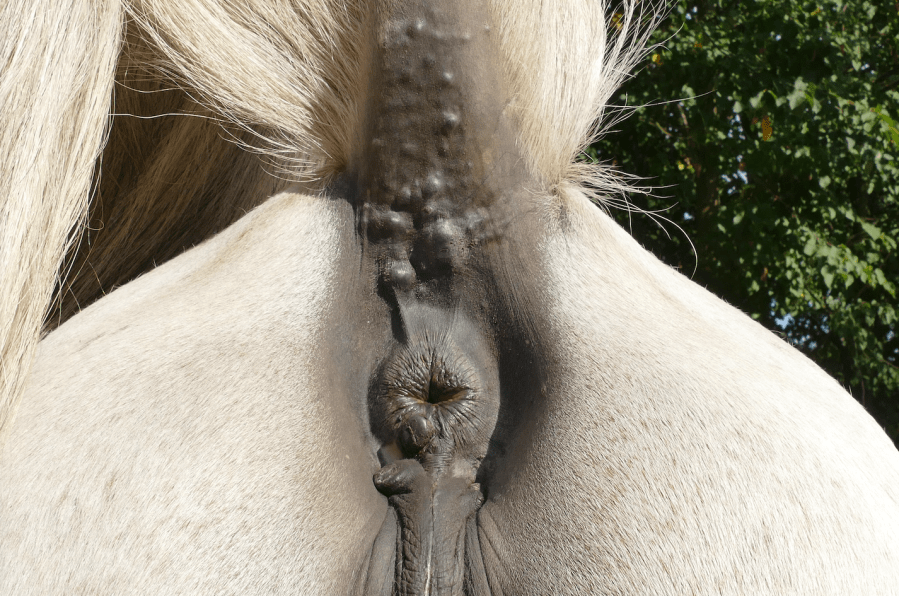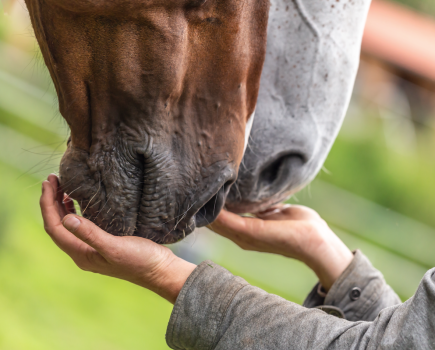A form of skin cancer that commonly affects grey, white and cremello horses of any breed or gender, melanomas are often benign, but nevertheless a worry for owners who may look for ways to treat and remove the tumours, possibly prompting a claim on your horse health insurance policy.
While melanomas have long been regarded as nothing more than unsightly, benign lumps — and more than 95% of cases are benign, at least when first diagnosed — there’s a growing body of evidence to suggest that some have the potential to become malignant.
It is thought that a significant proportion (30-60%) will spread to other areas of the horse’s body, including internal organs. Considering this, it’s important that any cancerous lumps are correctly identified and monitored by a vet.
What does a melanoma look like?
The size and colour of your horse’s lump, or lumps, will vary depending on the type of melanoma. Melanomas can be divided into the following three main types:
1 Dermal melanomas
This is the most common type of melanoma. Dermal melanonas usually affect greys who are aged between 13 and 17, and often grow in multiples around the horse’s anus, sheath, vulva or eyelids. These slow-growing lumps can appear as pigmented lumps or firm masses under the skin, and may ooze a black residue.
2 Melanocytic naevi
This type of melanoma is the rarest kind of tumour and is unusual in that they tend to affect younger horses — usually greys and coloured horses from birth up to the age of eight. They often develop as single lumps on the legs, neck, body and face.
3 Malignant malanomas
This is the rarest form of melanoma and also the most aggressive. Malignant melanomas can occur in any colour horse, but again are far more common in grey and light-coloured animals. They tend to develop in the same places as dermal melanomas, but are faster growing and often ulcerate to show a grey or grey-pink coloured surface.
The most aggressive form of the disease and their ability to spread to the horse’s internal organs can lead to weight loss, colic, respiratory problems and neurological signs, such as difficulty swallowing.
Can horse melanomas be prevented?
Sadly, there’s no way to prevent your horse from developing a melanoma, and if they’re grey or light coloured, the chances are they’ll be affected at some point in their life by one or more lumps.
If your horse is lucky, this may simply be a one-off, slow-growing, benign melanoma that doesn’t cause any problems, or they may be unlucky enough to suffer a cluster of fast-growing, aggressive lumps. Unfortunately, there’s no way to tell, and nothing you can do to stop them developing in the first place.
Some people have suggested that keeping a horse out of the direct sunlight during the hottest parts of the day, or applying sunscreen, may help prevent melanomas. However, this assumes the disease is the same in horses as it is in humans, and this isn’t the case. Solar radiation is unlikely to be the cause of the problem. It’s also impractical to keep a horse out of the sun, or apply sunscreen in such bulk!
How to treat horse melanomas
Single, smaller lumps of all three types of melanoma can be surgically removed, either via traditional methods or laser surgery, depending on where they are. Malignant melanomas, in particular, should be removed with some urgency as once they’ve spread internally treatment becomes impossible.
Many melanomas, particularly those around the anus and vulva, can be easily removed under standing sedation. Larger lesions, or those around the sheath of face, may need to be removed under general anaesthetic.
Tumours that have become too big to remove surgically, or which are in an awkward place, can be treated using cryotherapy. This involves freezing the tumour to reduce its size and slow its growth.
There is also a technique that involves injecting chemotherapy agents into the lumps, and this has proven successful in some cases. Cimetidine, an oral antacid, has also been shown to slow the rate of growth, though results have been varied.
Key facts about melanomas in horses
- Although single, isolated melanomas may not cause your horse a problem or affect them being ridden and worked as normal, it’s important to get your vet involved and ask their advice. Leaving a melanoma of any type untreated can be a risky strategy, so chat through the options with a vet.
- Dermal melanomas may be the most common type and often remain benign for years, but they can grow as large as 20cm and usually occur in clusters.
- Grey horses are particularly susceptible to melanomas, and it’s estimated that 80% of grey horses and ponies over the age of 12 will be affected by this form of skin cancer.
Main image copyright: Shutterstock








